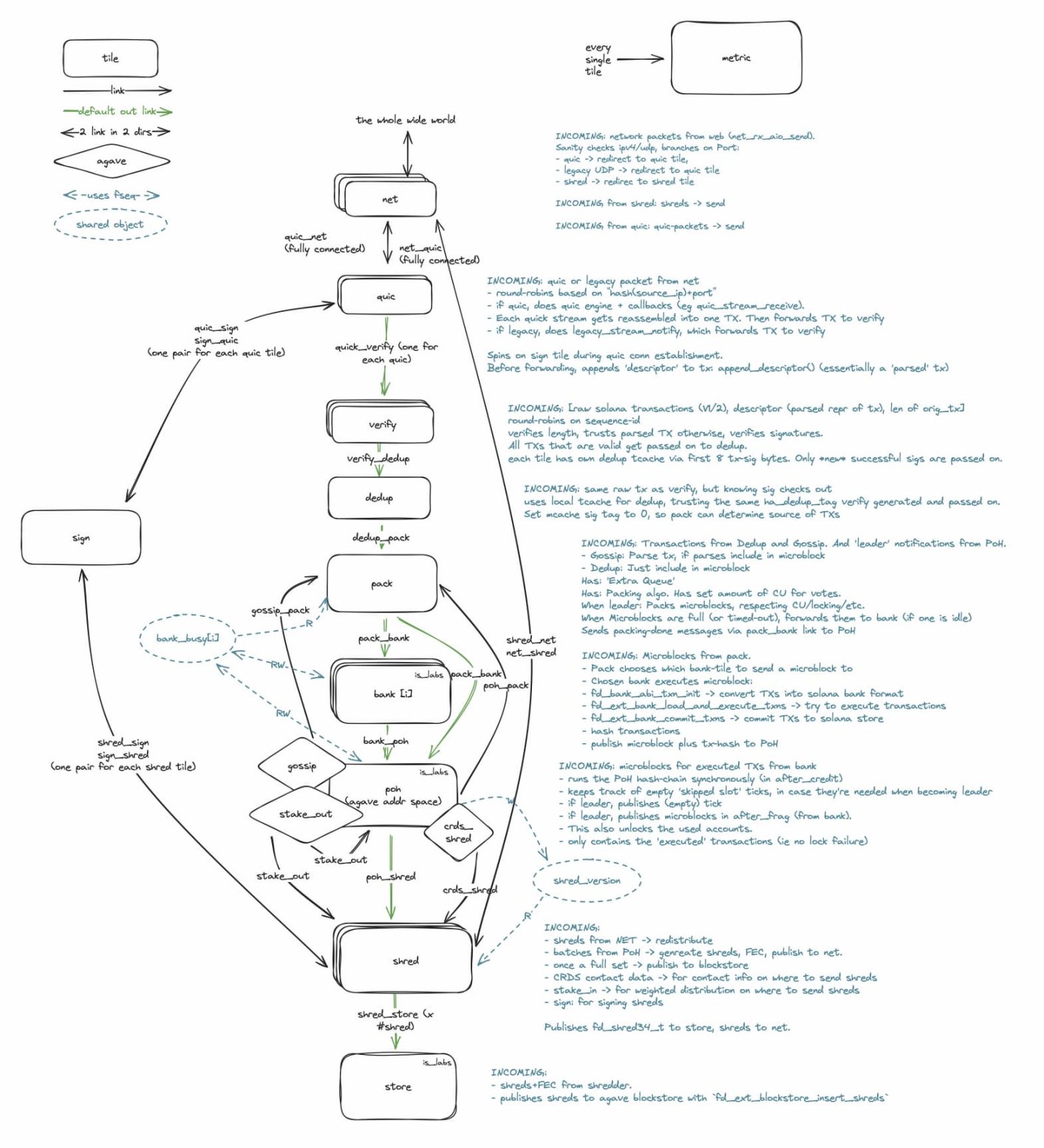原作者:Karen,前瞻新聞
上週的 Solana Breakpoint 大會現場氣氛熱烈,生態產品發表紛至沓來,各種豐富多彩的周邊活動更是錦上添花。本次盛宴的一大亮點是Solana驗證器用戶端早期版本Firedancer在主網上的正式上線。這項里程碑式的成就受到了特別關注,標誌著Solana網路將實現效能質的飛躍,同時避免了Solana上單一客戶端崩潰導致網路宕機的風險。
Firedancer的開發可以追溯到2021年和2022年。 ,增強整體的穩健性和彈性網路的。與原始的基於 Rust 的驗證器不同,Firedancer 用 C 編寫,不包含 Rust 程式碼。這個選擇顯著降低了潛在漏洞對整個網路的影響,為 Solanas 的安全又增添了一道堅實的防線。
火舞者的表現如何?
根據 Jump Crypto 首席科學官 Kevin Bowers 在 Solana Breakpoint 會議上的演講,Firedancer 展示了每秒處理超過 100 萬筆交易的能力,這一數字遠遠超過了 Solana 目前數萬 TPS 的理論極限。凱文鮑爾斯(Kevin Bowers)也將這一成就比喻為將“鄉間公路”拓寬為“州際公路”,預示著網路成本和容量的雙重優化。
Jump Trading核心工程師Liam Heeger分享了Firedancer在測試網的進展。客戶已成功產出超過20000個區塊,並實現質押比例1%。
另一位工程師 Aryaman Jain 進行了演示,進一步揭示了 Firedancer 在特定條件下的表現。例如,在擁有 10 個驗證器的環境中,其 TPS 可以達到數百萬,每秒處理超過 12 億個運算單元,同時也展示了 3.5 Gbps 的 Blockspace 容量和 50 萬 TPS 的 VM 執行效率。
火舞者如何工作?
Firedancer圍繞著三個主要元件建構:高效能運算堆疊和網路堆疊、運行時和共識機制。 Firedancers 能夠將 Solana 網路效能提升至 100 萬 TPS(目前協定級限制效能只能達到 81,000 TPS 左右)的關鍵在於其創新的架構設計和資料流優化。
驗證器採用並發模型,透過少量執行緒執行多樣化任務,每個執行緒專注於特定任務,例如網路封包處理、交易驗證、區塊打包等。提高了交易處理能力速度。
具體來說,每個執行緒執行 11 種不同作業之一。有些作業只需要一個執行緒來完成,但有些作業需要多個執行緒並行執行相同的工作。此外,每個執行緒都有一個CPU核心來運行,並且執行緒擁有該核心的所有權:它永遠不會休眠或讓作業系統將其用於其他目的。
Firedancer也引進了一種稱為tiles的架構,每個tile代表一個作業及其運行執行緒和分配的CPU核心。這種組合使得性能調優靈活高效。例如,net和quic的每個tile可以處理>100萬TPS,而verify和banktile則專注於交易驗證和區塊執行。雖然它們的處理速度比較低,但足以滿足高並發場景的需求。
Firedancer官方文件列出了11種圖塊,分別是:
-
net:從網路設備發送和接收網路封包(每塊可處理 >100 萬 TPS);
-
quic:接收來自客戶端的交易,執行所有連線管理和資料包處理,以管理和實現 QUIC 協定(每區塊可處理 >100 萬個 TPS);
-
驗證:驗證傳入交易的加密簽章並過濾掉無效交易(每個tile可以處理200,000-40,000 TPS);
-
dedup:檢查並過濾掉重複的傳入交易;
-
pack:成為領導者時,打包傳入的交易並聰明地安排它們執行;
-
銀行:執行預定交易(每個tile可以處理200,000-40,000 TPS);
-
Poh:是一種在後台持續執行哈希的機制,將產生的哈希值與執行的交易混合以證明順序性和及時性。
-
shred:成為leader時將區塊資料分發到網路;在不是領導者時接收並重傳區塊資料(吞吐量主要取決於叢集大小。在基準測試中,如果叢集規模較小,1 個瓦片可以處理 > 100 萬個 TPS);
-
store:成為Leader時接收區塊數據,或當其他節點成為Leader時接收來自其他節點的區塊數據,並將其儲存到本地磁碟的資料庫中;
-
metric:收集其他tile的監控資訊並提供給HTTP端點;
-
sign:持有驗證者私鑰,接收並回應來自其他tile的簽章請求。
值得注意的是,在Firedancer成熟之前,其過渡版本Frankendancer已經進入Solana主網。 Frankendancer 是 Firedancer 和部分 Agave 程式碼的混合體,結合了 Firedancer 在網路堆疊和區塊生產方面的優勢,同時保留了 Agaves 在執行和共識方面的功能。 Firedancer 完全是從頭開始建立的,不包含任何 Agave 程式碼。
火舞者有什麼影響?
毫無疑問,Firedancer的推出將對Solana生態產生重大影響。它將極大豐富驗證人的多樣性,進一步削弱單點故障對網路穩定性的影響,為Solana網路的可靠性建構更堅固的堡壘。
此外,Firedancer保持與現有協議的向後相容性,確保生態系統的平穩過渡,無需DApp開發者和用戶進行重大調整。
儘管 Firedancer 仍處於無投票模式,並且正在接受持續的優化和審核,但這為 Solana 網路的未來發展描繪了一幅更充滿希望的圖景。
參考:
1. https://www.youtube.com/watch?v=InGI7BDUeX4list=PLilwLeBwGuK4eY3nT0vvvJ4GmcJLImcQEindex=14
2. https://firedancer-io.github.io/firedancer/guide/tuning.html
3. https://solanacompass.com/learn/Validated/firedancer-w-kevin-bowers
本文來自網路:Breakpoint上備受期待的Firedancer簡介
相關:2024 年全球加密貨幣採用率調查:中亞、南亞和大洋洲領先世界
原作者:Chainaanalysis 團隊 原文翻譯:TechFlow 使用此互動式地圖查看您所在國家/地區在 2024 年 Chainaanalysis 全球加密貨幣採用指數中的排名。本文摘自我們的 2024 年加密貨幣地理報告。我們很高興與大家分享第五屆年度 Chainaanalysis 全球加密貨幣採用指數。在每年的報告中,我們都會分析鏈上和鏈下數據,以確定哪些國家在草根加密貨幣採用方面處於領先地位。我們的研究重點介紹了正在形成獨特加密貨幣用例的國家,並探討了為什麼世界各地的人們選擇接受加密貨幣。繼續閱讀以了解更多:全球加密貨幣採用指數方法;今年方法的改變; 2024 年全球加密貨幣採用指數排名前 20 名的國家;從該指數得出的主要結論。我們的全球方法論…










